- Medieval Ii Total War Free Download
- Medieval Ii Total War Map
- Medieval Ii Total War Download
- Medieval Ii Total War Center
More videos with GAMES vs GAMES here: Total War Medieval 2 Total War Medieval. Medieval II: Total War: Directed by Michael M. With Greg Baldwin, Tim Bentinck, Steffan Boje, Walter Bonacker. A diplomatic, strategic war game set between the years 1080 and 1530, focusing on medieval warfare, religion and politics in Europe, North Africa and the Middle East.
Brilliant, bloody, deep, and engaging, Medieval II: Total War simply has no equal among strategy games in terms of sheer variety of play. Sporting a real-time strategy combat engine hidden inside a sedate, turn-based strategy shell, M2:TW does both genres well enough to be good games in their own right, making the combination of the two all-but-irresistible. Moreover, the game's combat system, with its truly epic-feeling battles, may be the best RTS battle system seen in PC gaming to date.
In the game's 'Grand Campaign,' you will lead of one of Europe's fledgling nations to total domination of Europe, Asia, and the New World. Strategic decisions, such as managing settlements, moving units about, or keeping tabs your neighbors, take place on the Campaign Map, which has the look and feel of a Civilization game. As you upgrade cities, it's possible to see the countryside around them change from empty grassland to farmland and see the roads fill up with wagons trading goods to and from your ports.
While it's possible to spend many happy hours on the Campaign Map, it serves another purpose -- to build mighty armies to crush other nations. Long the hallmark of Total War games, these conflicts pit armies of hundreds and sometimes thousands against each other in medieval battles that would make William Wallace proud.
On the battlefield, it's possible to see an astonishing level of detail, right down to the faces of your men. By skillfully maneuvering your troops, it's often possible to defeat a numerically superior force. Unlike 'unit-based' RTS games, such as Age of Empires III, your units won't necessarily stay and fight to the death, but will break and run, spreading panic to others and turning a close battle into a rout. The game does a magnificent job dropping you into the thick of battle, and it's easy to get chills from these conflicts, especially when you're trying to form up your pikemen as gothic knights bear down on you and trebuchets in the distance rain numinous fire down on you.
A potential downside with M2:TW is that you'll need a hefty computer to get the most out of it -- all of those mud-spattered helmets and grimacing men come at a steep computing cost. Also, you cannot manage naval battles at all, perhaps understandable given M2:TW's fanatical focus on land-based battles.
Minor flaws aside, M2:TW stands with the very best PC strategy games. While other titles may do RTS or strategy better than this game, none offer the sterling synergy of both as M2:TW does.
Graphics: Incomparably complex battles, rendered and animated to bloody perfection.
Sound: The combat effects and voices are well done, but some variety on the Campaign Map tunes would have been nice.
Enjoyment: A joy to play.
Replay Value: A single Grand Campaign can easily take a week or more. Prepare to lose many weeks with this one.
For years the Total War franchise, with its unique mix of gameplay, has enjoyed continued success among hardcore strategy gamers. A very elaborate turn-based strategy game sits on top of a brilliant real-time battle mode. The latter realistically renders massive battles with hundreds and hundreds of individual soldiers, simulating true-to-the-era tactics and unit morale. Good planning and strategy in the turn-based game will give you the troops and equipment you'll need when it comes time to fight, and similarly, awesome performance on the real-time battlefield can help you make miracles happen on the turn-based map.
It's a winning combination, and once again it pays off with a solid strategy game. For players new to the Total War games looking for a hardcore medieval warfare strategy game, Medieval II: Total War delivers. But for fans of the franchise, the new title may fall short of expectations, offering little in the way of substantial improvements over 2004's excellent Rome: Total War.
Although Medieval II has a multiplayer battle mode and single-player battle missions, the real meat of the game and star of the show is the grand campaign. Here, players will take control of a European, North African, or Middle-Eastern kingdom in the year 1080. It's shortly after William the Conqueror took England by force, the Moors occupy half of the Spanish peninsula, and most of Europe is parceled out into mini-states and small fledgling kingdoms. The game progresses through several centuries of history, beyond the discovery of the New World, the European discovery of gunpowder, and the Mongol invasion from the East.
The campaign map is divided into provinces, each of which is governed by one main settlement. It's up to you to decide what buildings or improvements to build in each settlement, what the tax rate should be, how many troops to garrison, etc. Longtime Total War players will note the biggest difference here is that settlements can either be developed as cities or as castles. Cities can grow huge and are primarily economic drivers, allowing you to build improvements to the region's trade and productivity. But castles are where serious military units (like knights or heavy infantry) are built, and the population is easier to manage under the shadow of a fortress. It's possible for castles to be rebuilt into cities and vice versa, but this can be expensive and you'll lose high-level buildings in the process. While this change doesn't redefine the gameplay (most Total War players built specialized cities anyways), it definitely forces would-be conquerors to plan ahead. Once you get used to the change (and the frustration of trying to figure out which buildings can be built where), it adds some depth to the game.
Religion was a major factor in the development of nations during this period, and it's represented in-game. Religion is especially important for the Western-European Catholic factions, always under the watchful eye of the Pope. Every region has its own blend of faiths, the people divided among Catholics, Pagans, Heretics, Muslims, etc. Kings of a particular religion who try to control a region consisting mostly of a different faith will find it more prone to rebellion. Players can build Priest units and religious buildings to convert the population. In the Catholic kingdoms, Priest units can eventually be promoted to Cardinals, which is important because there's a new papal election every time the Pope passes away. Since the Pope has the power to excommunicate factions or call for crusades, he's one important hombre. The wheeling and dealing to gain favor with (or control of!) the Vatican is a very cool new addition to the game, a great layer of strategy sitting on top of the campaign.
That said, religion is almost overbalanced; a relatively inexpensive church building and a couple of priests can convert a 95% Muslim community into 80% Catholic within a handful of turns (and vice versa). Priests are inexpensive, so there's no real decision involved -- players would be stupid not to crank out an army of 'em.
Only five factions are playable in the campaign game at first (almost all Western-European rivals, such as England, France, or the Holy Roman Empire). Each time you win a campaign, a new faction is unlocked -- given that even the 'short' campaign is around 15 hours of gameplay, this restriction is really limiting. Fortunately, people have already discovered codes that allow you to unlock the full array of 17 different playable campaigns. The variety of kingdoms is one of the game's strengths, as the starting positions all offer unique challenges. Trying to play the smaller kingdoms (such as Portugal or Scotland) is a great test for any would-be monarch. It's strange that the developers chose to make unlocking all these other playable factions so difficult sans cheat code.
Battles in Medieval II: Total War are played out in real-time with hundreds of individually articulated 3D units, which in itself is visually spectacular. But above and beyond what we saw in Rome: Total War, the units have an individual detail that's inspiring once you zoom in to the action. Your troops, instead of being cookie-cutter soldiers, wear variants of your nation's historically-accurate armor and move as individuals. The combat animations are particularly gruesome.
Moreover, the backdrops are richly detailed, with weeds swaying at your soldier's feet or thick vegetation covering the forests. Sprawling cities or massive castles are awe-inspiring, as are the lush jungles of South America. (Only a small portion of the New World is rendered; just enough to give some flavor to the end-game.) While 90% of the new graphics aren't really noticeable until you zoom into the battle, there's a satisfying level of detail here above what Rome offered.
While Medieval II brings a lot of great gameplay to the table, some issues blunt the experience. The campaign mode starts off brilliantly, with players navigating through plenty of threats and tense diplomatic negotiations. But once you've conquered your local threats and established an economic base after a couple of hours of play, the campaign begins to slow down. Rome solved the problem by having the campaign game climax with a struggle for the Roman Capital, and Medieval II tries to address this by having late-game options such as conquering the Holy Land or invading the New World, but even hardcore strategy gamers might be put off by the hours of one-sided conflicts that arise once you've marshaled your forces and move to crush Europe's smaller powers one province at a time.
New additions to the game do more to slow it down than to address this problem. For example, you can build Merchants, who can travel the map acquiring and making money from map resources. Merchants trading close to your capital bring in only a trifle, so the only real way to earn money with them is to send them all the way across the map. There, they're vulnerable to being assassinated or taken over by rival merchants. For the minimal rewards, it's almost not worth the time.
The religious aspects of the game also contribute to dragging out the campaign. As mentioned, wrestling for political control of the Catholic Church is an interesting element. But moving priest units around the map and playing whack-a-mole with Heretic units that randomly appear and need to be denounced serves to slow down the game without really adding to the gameplay.
The game's AI on the big map is sometimes flawed. Large, lavish, wealthy coastal cities are often left undefended -- easy targets for anyone with a stack of units and a fleet. Within the real-time battles, the AI is a competent (if not brilliant) opponent, but will sometimes stand still and allow you to pelt it with arrows unopposed.
Undefended coastal cities are just one flaw that can be exploited. For example, during castle sieges, once the enemy has retreated to the inner keep of a castle, you can run your troops into the town walls and then cross over to the inner castle walls, usually unopposed, even going so far as to open the gate for yourself. None of these are major issues, but they pull down the campaign experience somewhat -- sometimes you feel like you're exploiting your way across the continent instead of winning it through grit and guile.
Gamers who've played Rome: Total War, especially with the excellent Barbarian Invasion expansion, may sense some d¿j¿ vu on the Medieval II map. It may have more detail, but you're fighting over essentially the same Eurasian and North African terrain as the previous title, which takes away from the game's novelty.
While the single-player game is clearly the focus of the title, the multiplayer mode is very polished. As with the other games in the Total War franchise, only the real-time battles are playable in multiplayer. A built-in server browser allows you to chat with your fellow Kings and quickly jump into a game. At the time of this writing, there were usually dozens of games being set up at any given time, with no problems connecting to any.
One-on-one matches with big armies were common, but it's possible to set up brutal eight-player throwdowns across a multitude of terrains. The only problem with the multiplayer is that some players couldn't handle large battles with their systems -- and if one player lags, the whole battle may lag. Players seem to be learning this. The best thing to do is stick to more manageable battle sizes. Even 'manageable' battles have over a thousand units on the screen, so multiplayer games definitely capture the feel of all-out warfare. Human opponents are not so easily fooled as the AI and the tactics are far deeper in the multiplayer game.
The final word on Medieval II is that, despite some problems, it's still a great strategy game. Even with the A.I. issues, the game still puts up an interesting fight -- you're constantly negotiating your way through twisting allegiances and bitter rivals taking shots at your empire. The battle simulations themselves are many times more detailed than in other strategy games, and feature true-to-life tactics that never grow old. Longtime fans of games like Rome: Total War may fault the game for not adding more, but if you're looking for a solid strategy title, Medieval II: Total War delivers.
People who downloaded Medieval II: Total War have also downloaded:
Rome: Total War, Medieval: Total War, Shogun: Total War, Age of Empires III, Lord of the Rings, The: The Battle for Middle Earth II, Age of Empires 2: The Age of Kings, Sid Meier's Pirates!, Sid Meier's Civilization IV
Bastard ncsoft drummer boys!I'm sitting here at the world's largest games convention about to see one of the highlights of E3 2006, and all I can hear is the incessant poundings of a bunch of music student hippies hired by NCsoft to piss off anyone within a 30-mile radius of their stand.Still, it could be worse. The Creative Assembly's Ian Roxburgh and Mark Sutherns have been sitting next to these beat boys for the past two days, so much so that they've perfected the art of presenting Medieval 2 at a volume rivalling a pneumatic drill.
It's been just five months since we broke the news that the Total War family was soon to have a fourth arrival, but with Roxburgh and Sutherns in the mood to extol the virtues of their game, it's immediately apparent that they're keen to spill enough Medieval 2 beans to cover almost three pieces of toast.
'Everything is bigger and better than Rome' yells Roxburgh as he begins his presentation. 'The battles have double the polygons, each troop is unique and there are numerous combat variations with thrusts, parries and fatality moves. We've also doubled the textures on the campaign map, and there are twice as many voiceovers and sound effects. We've even ensured that each nation has the correct accent.'
Shout It Out
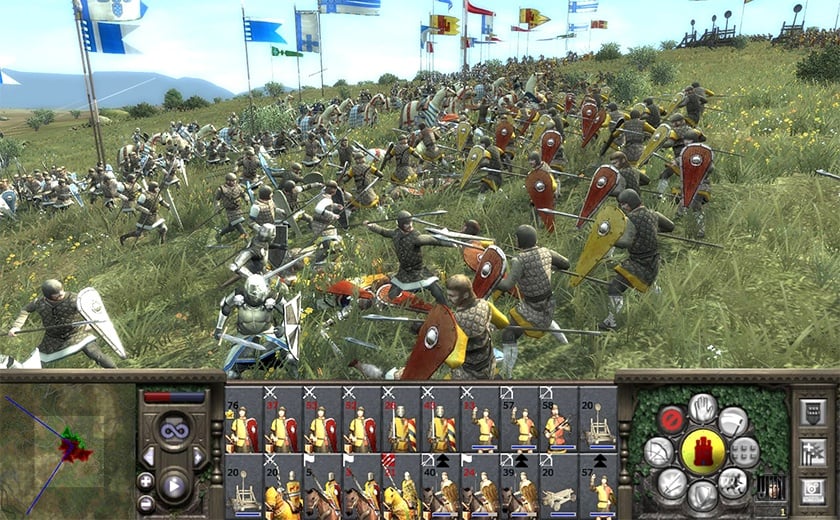
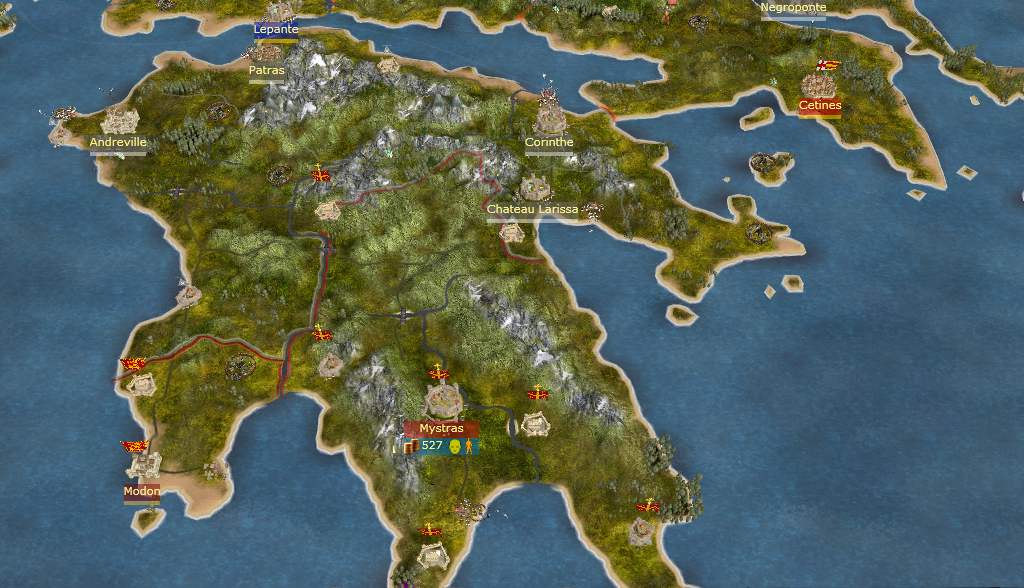
Roxburgh zooms into the campaign map, which radiates a refined clarity and depth of detail when compared to Rome's worldview. But the strategic map's enhancements run far deeper than cosmetics. 'We're adding loads of new features,' he bellows. 'Click on any faction on the map and it'll give you a voiceover that reflects how it feels towards you. If a nation is amenable to you, they'll greet you, while a hostile nation will be far more aggressive. You'll no longer have to use the Diplomacy screen to find out how a nation feels.' While Total War has been at the forefront of strategic innovation for the best part of six years now, one area that's lacked depth has been diplomacy, a failing that the team are keen to rectify. 'We've spent a lot of time improving diplomacy,' screams Roxburgh, as blood begins to seep from my eardrums.
'In Medieval2, the Al will not only remember previous dealings you've had with it but your dealings with other factions, too. It'll then base its stance towards you on all of those factors.'Another new addition to the strategic map are princesses - pawns that can be used in a variety of underhand ways. Little more than whores in expensive garbs, these harlot diplomats can be prostituted to make alliances with rival factions (through arranged marriages), or sent to seduce enemy generals to your cause.
While we're on the subject of generals... 'Each general's personality will have different effects on the battlefield or within cities,' roars Roxburgh. 'A general's attributes can also change, depending on how they conduct themselves on the battlefield.' Mercilessly slaughter the prisoners you capture during a battle (a feature reprised from the original Medieval} and your general's 'dread' rating will rocket, making enemies fearful on the battlefield and civilians more obedient within cities. And while showing mercy m war may make your generals a target for big girly girl' remarks from opposing armies, at least the people will love them should you order them to liabysit a settlement. Unless of course they raid the fridge, invite over their girlfriend and leave sticky stains on the sofa, in which case, they could be faced with a revolution.
Hostile Intent
Also adding to the campaign map's strategic depth are merchants, a group of money-grabbing capitalists whose sole purpose in life is to amass money and resources through any means necessary.'If you want to delve a little deeper into the economy, you'll be able to move merchants to pockets of resources dotted around the map,' howls Roxburgh. If allied factions have merchants guarding a resource, you can attempt a hostile takeover and force them off. It's like an economic rivalry that's totally separate to being at war with a faction'
Next up are heretics and witches, heathen wanderers who spread religious doubt throughout your provinces (causing social unrest) and convert impressionable priests to their way of thinking.'Heretics and witches will appear at various times and permeate through your land spreading heresy,' Roxburgh continues, during a rare respite from the NC soft stand. 'You can send in priests to convert them, but if they fail, they'll be turned into heretics too.' And yes, you can burn them.
Kick Up The Arse
Medieval Ii Total War Free Download
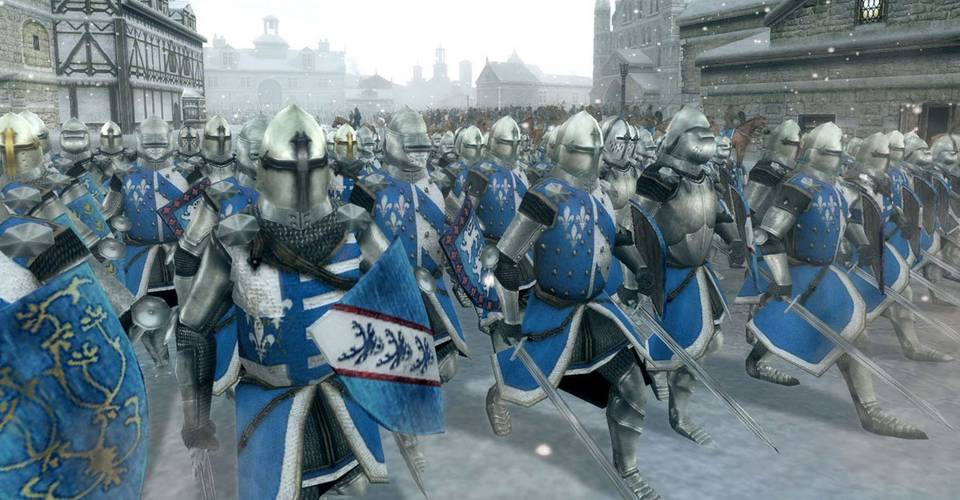
Avid Total War fans will be happy to know that the assassination animations - brief cut-scenes, which chart the success or failure of a professional hit -are Ixick after their disappearance in Medieval and Rome. 'We have loads of these, so it's unlikely you'll ever see the same one twice,' screeches Roxburgh as the cacophony restarts. 'There are different movies for all of the different targets you can kill, for successes, failures and even ones for when the target manages to escape,' adds Mark Sutherns. Unlike Shogun's basic and repetitive animations, these murderous moments prove of the highest quality, perfectly raising that tension before reaching their unpredictable conclusions.
Another criticism of Rome was the relative comfort you'd enjoy once you'd built up a sizeable empire. With your capital city surrounded by vassal states, your kingdom's epi-centre would rarely feel threatened. Not this time, though.
'We're making the campaign map Al far more proactive than before. You'll find that your homeland will be attacked a lot more. Your enemies may stick a large army on a fleet and come and attack you at your main city. That's why all of the city fortifications you've built up for your main cities will become far more important this time around,' hollers Roxburgh.
What's more, once your medieval empire becomes overwhelmingly powerful, you'll quickly find your rivals rallying together to oppose your expanding kingdom, a feature which the team hopes will make the game challenging from beginning to end. So, with the strategic map clearly enjoying a sizeable makeover, we move on to the part I've really been waiting for the most, the real-time battles...
To War!
During the course of the next 20 minutes, I sit through three battles, each one more brutal and cinematicthan the last.
First off is the age-old grudge match between the English and the French, set in lush surroundings flanked on both sides by dense forests. With Roxburgh's English forces dug in along a ridge, the French infantry launch an audacious bid to turn themselves into gallic kebabs as they march straight onto a row of spikes placed down by his archers (an all-new feature), while they send their cavalry through the trees to launch a surprise attack. Misjudged in the extreme, Roxburgh quickly dispatches an attempted foot soldier diversion, leaving the French mounted knights isolated and vulnerable.
What strikes me most though isn't the French tactical naivety, but the breathtaking level of detail that these battles contain. Gone are the clone armies of Rome, replaced by rows of unique soldiers, their armour acquiring blood and mud as they duel with their opponents, before visibly scanning their surroundings for their next victim.
Dead bodies now stack up in horrific mounds - rather than the flat 2D corpses of Rome - while the battle physics have clearly enjoyed a makeover, with clashes looking more brutal and jarring than ever before. Individual blades of grass sway in the breeze, shrubs look prunable, weather changes dynamically and night-time battles are looking more visually impressive than ever, while every armour and weapon upgrade you make in the strategic map is now visually represented on the real-time battlefield.
Medieval Ii Total War Map
Wall Fall
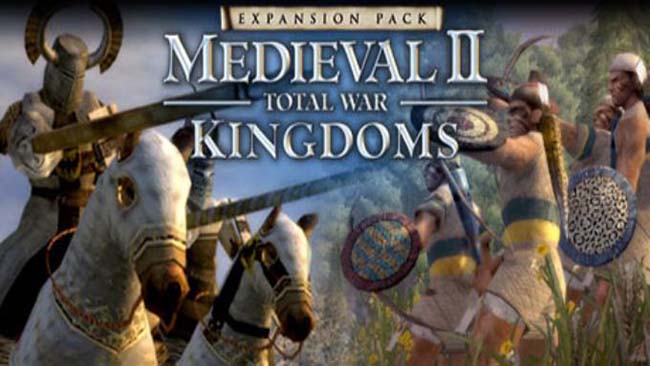
Battle number two is a desert skirmish. English crusaders battle the Egyptians, pounding the massed enemy ranks with mighty cannons. Finally, Roxburgh takes on an Aztec tribe. After obliterating their city walls with siege weapons (walls now crumble brick by brick, rather than in massive sections), the Iiainted South Americans spill out of the gates in their thousands, only to be to slaughtered by superior tactics and swords that aren't made from wood.
There'll be loads of new features in these battles that you'll have to take into account, like impassable terrain. The Al will look at that and think of how it can use it to its advantage,' bellows Sutherns. 'We've done hundreds of hours on the animation work, so that the battles feel far more realistic and fluid.'
For now, that's all there is, but I've seen and heard more than enough to reinforce my belief that this next Total V/cir instalment could well pick up the baton from Rome and raise the RTS bar to even greater heights. As Sutherns and Roxburgh bid me a hoarse farewell, I leave their booth energised, ears ringing and bloodied, and ready to kill myself some drummer boys.
Papal politics
The pope and the crusades will play a far more prominent role than they did in the original Medieval. For starters, you'll have to manage your relationship with the pope much more carefully, ensuring you build plenty of churches and cathedrals, while making sure you stamp out any heretics or witches before they have a chance to infect your populace with their heathen views.However, if you fancy installing one of your own priests into the Vatican, you'll first need to get them elected to the College of Cardinals, then either win votes through virtuous deeds or by bribing other nations with fat wads of non-sequential bills stuffed into brown envelopes.q
Once you build up enough influence with the pope, you'll then be able to persuade him to call crusades that are beneficial to your nation, at which point a bunch of inbred rich boys will march to their deaths to extend your holdings under the pretence of religious duty. To help speed them to their graves will be a double movement bonus as well as a battlefield cross that acts as a morale-boosting emblem. For the king, for god, for increased economical stability... To war!
The American dream
Medieval Ii Total War Download
Towards the latter stages of the game, an historical event will insinuate that there could be land across the sea. That place is, of course, the Americas. Teeming with resources, you and every other nation will suddenly become locked in a race to get over there, cleanse the lands of any indigenous people (aka The Aztecs) and liberate all of the natural resources from these brutal, heathen, heretical barbarians who dare inhabit an area of such economic wealth.
Medieval Ii Total War Center
But bolstering your coffers with the blood of innocent American tribes won't be easy. While their technology and weapons may be primitive (seems the nearest these boys ever came to armour was body paint), you'll soon discover that not only are they incredibly brave warriors, but that there's 'fahsands of 'em', too. However, if you manage to pull it off and conquer the lands for yourself, you'll find yourself top of the Medieval Rich List in no time.